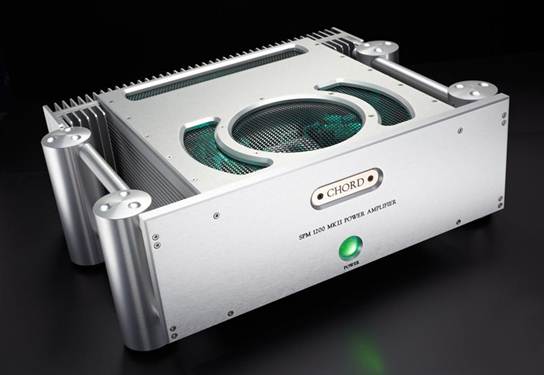It’s big, it’s beautiful and it lights up at night! We are
beguiled by Chord’s latest SPM 1200 MkII solid-state power amplifier.
On the great power amplifier firmament, this has got the
lot. The new Chord SPM 1200 MkII is physically large. It is beautifully
presented with immaculate aerospace-grade aluminium surfacing and has a
striking, architectural quality to its styling. And even if it’s striking,
colorful interior down lighting isn’t suited to all tastes, it is still one
heck of a piece of work. Put it in your listening room, and it suddenly looks a
less shabby place!

Get set for a
light show like fireworks night…
More than this though, it has got to sound the part. And to
this end there is a special sliding bias circuit designed to reconcile the
often mutually exclusive quest for high power and fine sound quality. Inside
are 16 power MOSFETs, which run in Class A mode up to a point, where they
‘intelligently’ switch to Class AB. The result is that at lower volumes they
avoid switching distortion and the grainy sound that can ensue. At higher
volumes, they move to Class AB mode where they thump out a claimed 350W RMS
into 8 ohms. As most music listening is done at relatively low power output
levels – even when the music sounds quite ‘loud’ an amplifier is rarely putting
out more than 10W – the Chord works in Class A most of the time. But for short
bursts of transient power, the bias switches and the amp gets to do some heavy
lifting. It’s clever stuff, but to be fair it isn’t new; Marantz was doing
something similar with its ‘Quarter A’ amplifiers in the eighties.
The company has obviously paid a lot of attention to
everything that a high-end ‘super amp’ needs. It has a beefy power supply, with
the supply rails operating at a giddy ±90V from a switched mode power supply
(which explains why it is a little lighter than some rivals). Chord uses what
it calls ‘dynamic coupling’ here; whatever any transient demand is presented to
the amplifier stages, the positive and negative rails remain in perfect
equilibrium, with each compensating for the demands made on the other. The
output signal path is devoid of sound-degrading fuses or resistive components
employed for overload sensing. Chord says it uses “the best high voltage,
lateral structure MOSFETs available”; these run warm, but not hot, likely due
to the sliding bias design.

Chord says it uses
“the best high voltage, lateral structure MOSFETs available”
This new MkII version gets a range of tweaks inside, from a
new power-control and sequencing board to refinements to the filter components
of the subsequent amplifier stages, to insure greater high-speed performance
while maintaining overall stability. Numerous circuit board and earthling
changes have been made to improve high-current power flow across the units and
help extend the product’s lifecycle, the company says. There’s also a reduction
of the value of the emitter balancing resistors in the first long tail pair in
the second intermediate stage of the amplifier, for a faster overall response;
this is also said to the improve the high frequency response.
The SPM 1200 MkII gets a lavishly finished, beautifully
styled case, which looks more like something you’d see in a science fiction
film than on your Hi-Fi rack. Just to add to the thrill, it is lit up like the
Pudong side of Shanghai; gasp in amazement as green, yellow and blue LEDs
scatter a dramatic light-show inside and outside the case. Personally I am not
a fan, but at least Chord has tried to do something different.
RCA and XLR inputs, plus chunky speaker terminals complete
the rear picture, plus an (annoyingly) non-standard IEC mains inlet.
Sound quality
The big Chord doesn’t sound as showy as it looks – its sonic
character is more subtle than its appearance. What you get is a well-engineered
solid-state power amplifier that has very few faults and shines through its
overall, across-the-board competence. It doesn’t have a big, fun character and
nor will it wow you and amaze; rather, it gets on with the job asked of it with
consummate ease, genuine ability and no small degree of finesse.

The big Chord
doesn’t sound as showy as it looks – its sonic character is more subtle than
its appearance.
Simple Minds’ Someone, Somewhere, In Summertime is an
unalloyed pleasure. The SPM 1200 carefully sets up a large, deep soundstage,
inside which instruments are placed with meticulous accuracy. Whether it is the
pounding snare drums or those dreamy, ethereal vocals, everything is rock-solid
and clear as day. Indeed this amp sounds very transparent, letting the listener
right into the mix, allowing them to focus on all the different strands with
consummate ease. Unlike some rival solid-state designs, the sound is never
opaque or hazy; there’s none of that transistor grey mist that so often
permeates the middle-distance of the recorded acoustic. Rather, the Chord opens
a wide window on to the music for you.
However, it does not come over as bright. There’s no sense
of the white halogen light that the full Class A Musical Fidelity AMS50 shines
on things, for example. This isn’t to say that the Chord sounds dark and
velvety like many tube amps either, it’s just that it strikes a really skilful
balance between the two extremes. This means you can play a very forward and
bracing track, such as Period Music by High Llamas, and its searing steel
string guitars won’t take your head off. To my ears it gets the balance just
right.